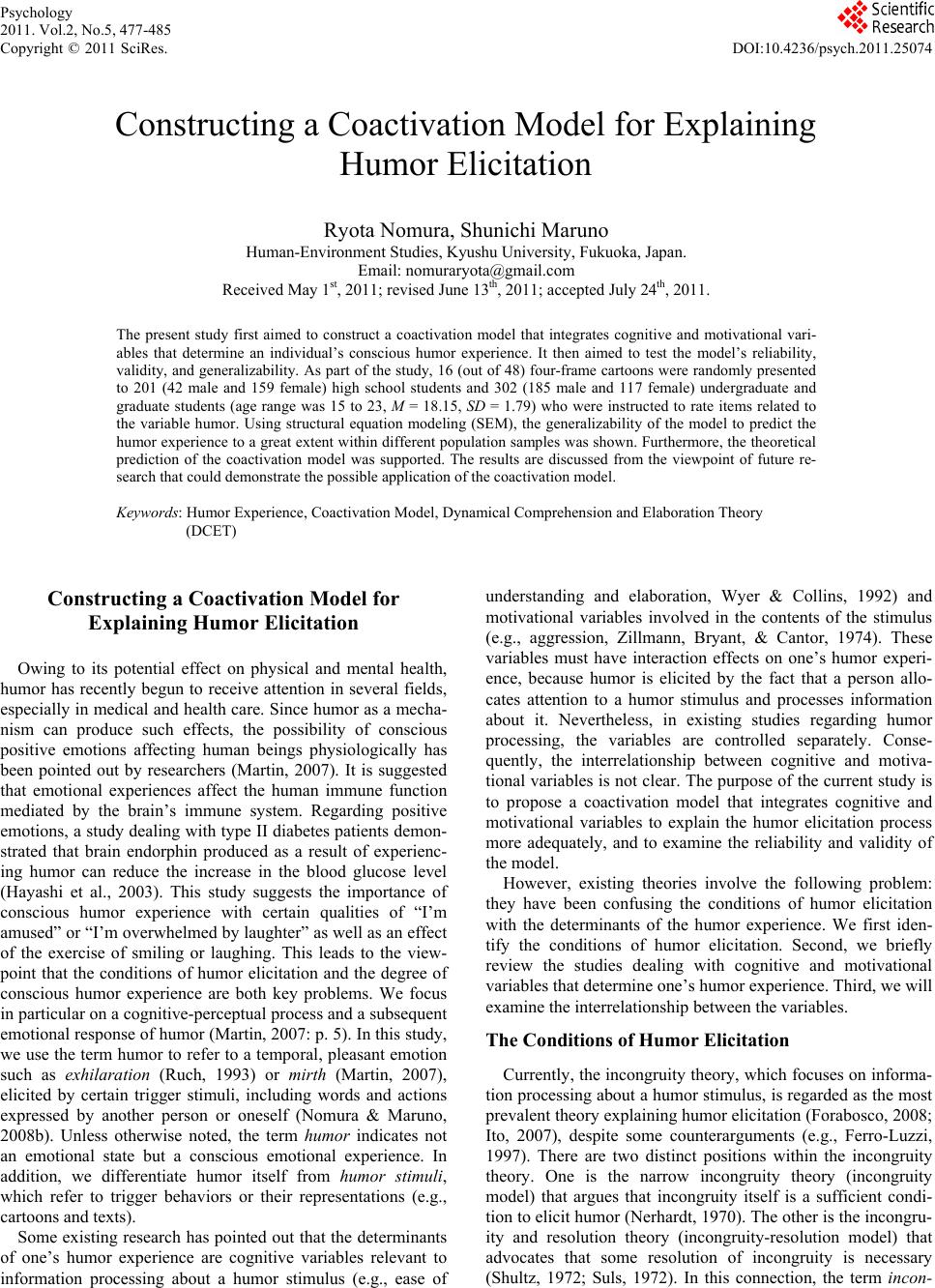 Psychology 2011. Vol.2, No.5, 477-485 Copyright © 2011 SciRes. DOI:10.4236/psych.2011.25074 Constructing a Coactivation Model for Explaining Humor Elicitation Ryota Nomura, Shunichi Maruno Human-Environment Studies, Kyushu University, Fukuoka, Japan. Email: nomuraryota@gmail.com Received May 1st, 2011; revised June 13th, 2011; accepted July 24th, 2011. The present study first aimed to construct a coactivation model that integrates cognitive and motivational vari- ables that determine an individual’s conscious humor experience. It then aimed to test the model’s reliability, validity, and generalizability. As part of the study, 16 (out of 48) four-frame cartoons were randomly presented to 201 (42 male and 159 female) high school students and 302 (185 male and 117 female) undergraduate and graduate students (age range was 15 to 23, M = 18.15, SD = 1.79) who were instructed to rate items related to the variable humor. Using structural equation modeling (SEM), the generalizability of the model to predict the humor experience to a great extent within different population samples was shown. Furthermore, the theoretical prediction of the coactivation model was supported. The results are discussed from the viewpoint of future re- search that could demonstrate the possible application of the coactivation model. Keywords: Humor Experience, Coactivation Model, Dynamical Comprehe nsion and El aboration Theory (DCET) Constructing a Coactivation Model for Explaining Humor Elicitation Owing to its potential effect on physical and mental health, humor has recently begun to receive attention in several fields, especially in medical and health care. Since humor as a mecha- nism can produce such effects, the possibility of conscious positive emotions affecting human beings physiologically has been pointed out by researchers (Martin, 2007). It is suggested that emotional experiences affect the human immune function mediated by the brain’s immune system. Regarding positive emotions, a study dealing with type II diabetes patients demon- strated that brain endorphin produced as a result of experienc- ing humor can reduce the increase in the blood glucose level (Hayashi et al., 2003). This study suggests the importance of conscious humor experience with certain qualities of “I’m amused” or “I’m overwhelmed by laughter” as well as an effect of the exercise of smiling or laughing. This leads to the view- point that the conditions of humor elicitation and the degree of conscious humor experience are both key problems. We focus in particular on a cognitive-perceptual process and a subsequent emotional response of humor (Martin, 2007: p. 5). In this study, we use the term humor to refer to a temporal, pleasant emotion such as exhilaration (Ruch, 1993) or mirth (Martin, 2007), elicited by certain trigger stimuli, including words and actions expressed by another person or oneself (Nomura & Maruno, 2008b). Unless otherwise noted, the term humor indicates not an emotional state but a conscious emotional experience. In addition, we differentiate humor itself from humor stimuli, which refer to trigger behaviors or their representations (e.g., cartoons and texts). Some existing research has pointed out that the determinants of one’s humor experience are cognitive variables relevant to information processing about a humor stimulus (e.g., ease of understanding and elaboration, Wyer & Collins, 1992) and motivational variables involved in the contents of the stimulus (e.g., aggression, Zillmann, Bryant, & Cantor, 1974). These variables must have interaction effects on one’s humor experi- ence, because humor is elicited by the fact that a person allo- cates attention to a humor stimulus and processes information about it. Nevertheless, in existing studies regarding humor processing, the variables are controlled separately. Conse- quently, the interrelationship between cognitive and motiva- tional variables is not clear. The purpose of the current study is to propose a coactivation model that integrates cognitive and motivational variables to explain the humor elicitation process more adequately, and to examine the reliability and validity of the model. However, existing theories involve the following problem: they have been confusing the conditions of humor elicitation with the determinants of the humor experience. We first iden- tify the conditions of humor elicitation. Second, we briefly review the studies dealing with cognitive and motivational variables that determine one’s humor experience. Third, we will examine the interrelationship between the variables. The Conditions of Humor Elicitation Currently, the incongruity theory, which focuses on informa- tion processing about a humor stimulus, is regarded as the most prevalent theory explaining humor elicitation (Forabosco, 2008; Ito, 2007), despite some counterarguments (e.g., Ferro-Luzzi, 1997). There are two distinct positions within the incongruity theory. One is the narrow incongruity theory (incongruity model) that argues that incongruity itself is a sufficient condi- tion to elicit humor (Nerhardt, 1970). The other is the incongru- ity and resolution theory (incongruity-resolution model) that advocates that some resolution of incongruity is necessary (Shultz, 1972; Suls, 1972). In this connection, the term incon- 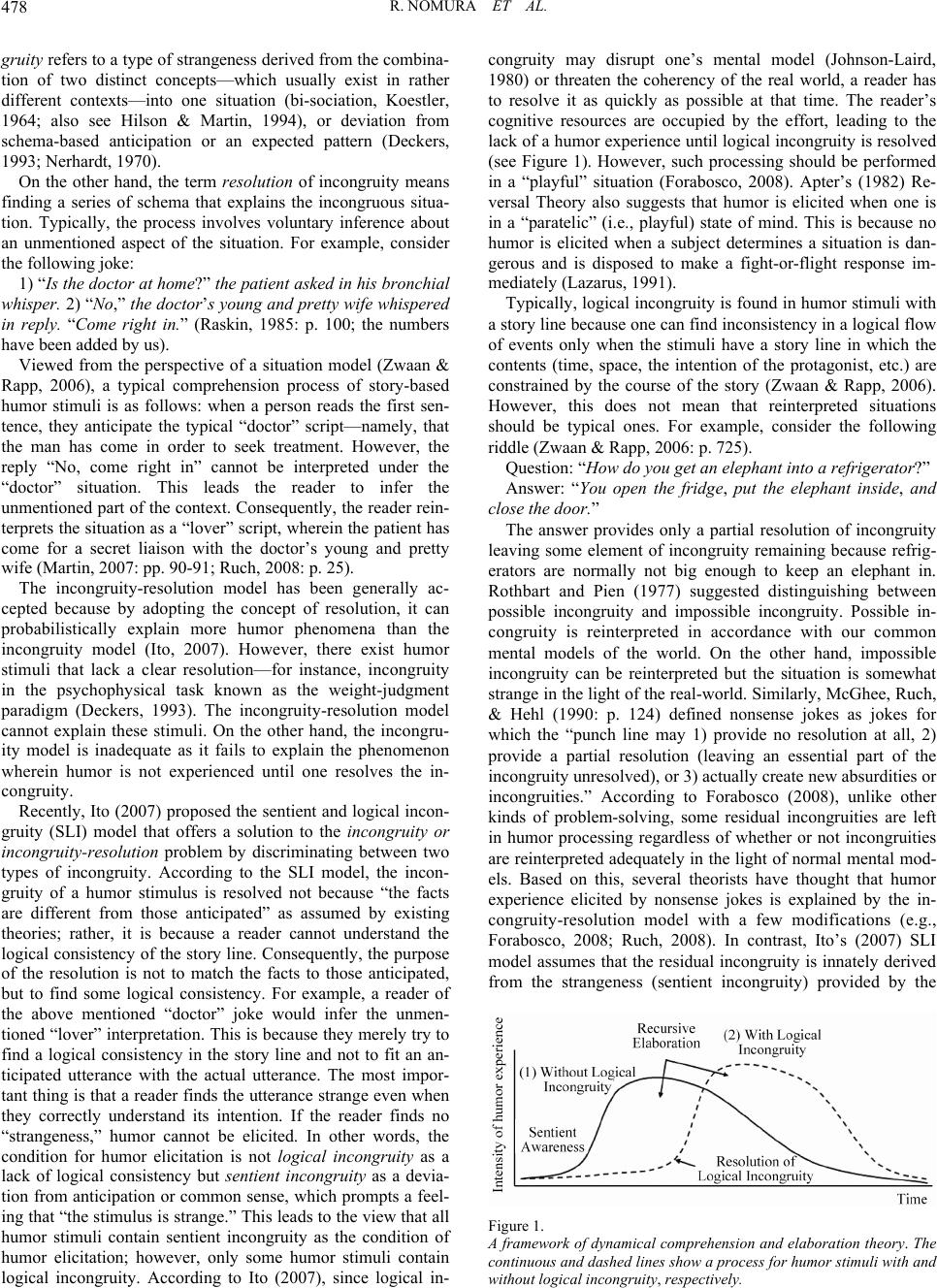 R. NOMURA ET AL. 478 gruity refers to a type of strangeness derived from the combina- tion of two distinct concepts—which usually exist in rather different contexts—into one situation (bi-sociation, Koestler, 1964; also see Hilson & Martin, 1994), or deviation from schema-based anticipation or an expected pattern (Deckers, 1993; Nerhardt, 1970). On the other hand, the term resolution of incongruity means finding a series of schema that explains the incongruous situa- tion. Typically, the process involves voluntary inference about an unmentioned aspect of the situation. For example, consider the following joke: 1) “Is the doctor at home?” the patient asked in his bronchial whisper. 2) “No,” the doctor’s young and pretty wife whispered in reply. “Come right in.” (Raskin, 1985: p. 100; the numbers have been added by u s). Viewed from the perspective of a situation model (Zwaan & Rapp, 2006), a typical comprehension process of story-based humor stimuli is as follows: when a person reads the first sen- tence, they anticipate the typical “doctor” script—namely, that the man has come in order to seek treatment. However, the reply “No, come right in” cannot be interpreted under the “doctor” situation. This leads the reader to infer the unmentioned part of the context. Consequently, the reader rein- terprets the situation as a “lover” script, wherein the patient has come for a secret liaison with the doctor’s young and pretty wife (Martin, 2007: pp. 90-91; Ruch, 2008: p. 25). The incongruity-resolution model has been generally ac- cepted because by adopting the concept of resolution, it can probabilistically explain more humor phenomena than the incongruity model (Ito, 2007). However, there exist humor stimuli that lack a clear resolution—for instance, incongruity in the psychophysical task known as the weight-judgment paradigm (Deckers, 1993). The incongruity-resolution model cannot explain these stimuli. On the other hand, the incongru- ity model is inadequate as it fails to explain the phenomenon wherein humor is not experienced until one resolves the in- congruity. Recently, Ito (2007) proposed the sentient and logical incon- gruity (SLI) model that offers a solution to the incongruity or incongruity-resolution problem by discriminating between two types of incongruity. According to the SLI model, the incon- gruity of a humor stimulus is resolved not because “the facts are different from those anticipated” as assumed by existing theories; rather, it is because a reader cannot understand the logical consistency of the story line. Consequently, the purpose of the resolution is not to match the facts to those anticipated, but to find some logical consistency. For example, a reader of the above mentioned “doctor” joke would infer the unmen- tioned “lover” interpretation. This is because they merely try to find a logical consistency in the story line and not to fit an an- ticipated utterance with the actual utterance. The most impor- tant thing is that a reader finds the utterance strange even when they correctly understand its intention. If the reader finds no “strangeness,” humor cannot be elicited. In other words, the condition for humor elicitation is not logical incongruity as a lack of logical consistency but sentient incongruity as a devia- tion from anticipation or common sense, which prompts a feel- ing that “the stimulus is strange.” This leads to the view that all humor stimuli contain sentient incongruity as the condition of humor elicitation; however, only some humor stimuli contain logical incongruity. According to Ito (2007), since logical in- congruity may disrupt one’s mental model (Johnson-Laird, 1980) or threaten the coherency of the real world, a reader has to resolve it as quickly as possible at that time. The reader’s cognitive resources are occupied by the effort, leading to the lack of a humor experience until logical incongruity is resolved (see Figure 1). However, such processing should be performed in a “playful” situation (Forabosco, 2008). Apter’s (1982) Re- versal Theory also suggests that humor is elicited when one is in a “paratelic” (i.e., playful) state of mind. This is because no humor is elicited when a subject determines a situation is dan- gerous and is disposed to make a fight-or-flight response im- mediately (Lazarus, 1991). Typically, logical incongruity is found in humor stimuli with a story line because one can find inconsistency in a logical flow of events only when the stimuli have a story line in which the contents (time, space, the intention of the protagonist, etc.) are constrained by the course of the story (Zwaan & Rapp, 2006). However, this does not mean that reinterpreted situations should be typical ones. For example, consider the following riddle (Zwaan & Rapp, 2006: p. 725). Question: “How do you get an elephant into a refrigerator?” Answer: “You open the fridge, put the elephant inside, and close the door.” The answer provides only a partial resolution of incongruity leaving some element of incongruity remaining because refrig- erators are normally not big enough to keep an elephant in. Rothbart and Pien (1977) suggested distinguishing between possible incongruity and impossible incongruity. Possible in- congruity is reinterpreted in accordance with our common mental models of the world. On the other hand, impossible incongruity can be reinterpreted but the situation is somewhat strange in the light of the real-world. Similarly, McGhee, Ruch, & Hehl (1990: p. 124) defined nonsense jokes as jokes for which the “punch line may 1) provide no resolution at all, 2) provide a partial resolution (leaving an essential part of the incongruity unresolved), or 3) actually create new absurdities or incongruities.” According to Forabosco (2008), unlike other kinds of problem-solving, some residual incongruities are left in humor processing regardless of whether or not incongruities are reinterpreted adequately in the light of normal mental mod- els. Based on this, several theorists have thought that humor experience elicited by nonsense jokes is explained by the in- congruity-resolution model with a few modifications (e.g., Forabosco, 2008; Ruch, 2008). In contrast, Ito’s (2007) SLI model assumes that the residual incongruity is innately derived from the strangeness (sentient incongruity) provided by the Figure 1. A framework of dynamical comprehension and elaboration theory. The continuous and dashed lines show a process for humor stimuli with and without logical incongruity, respectively. 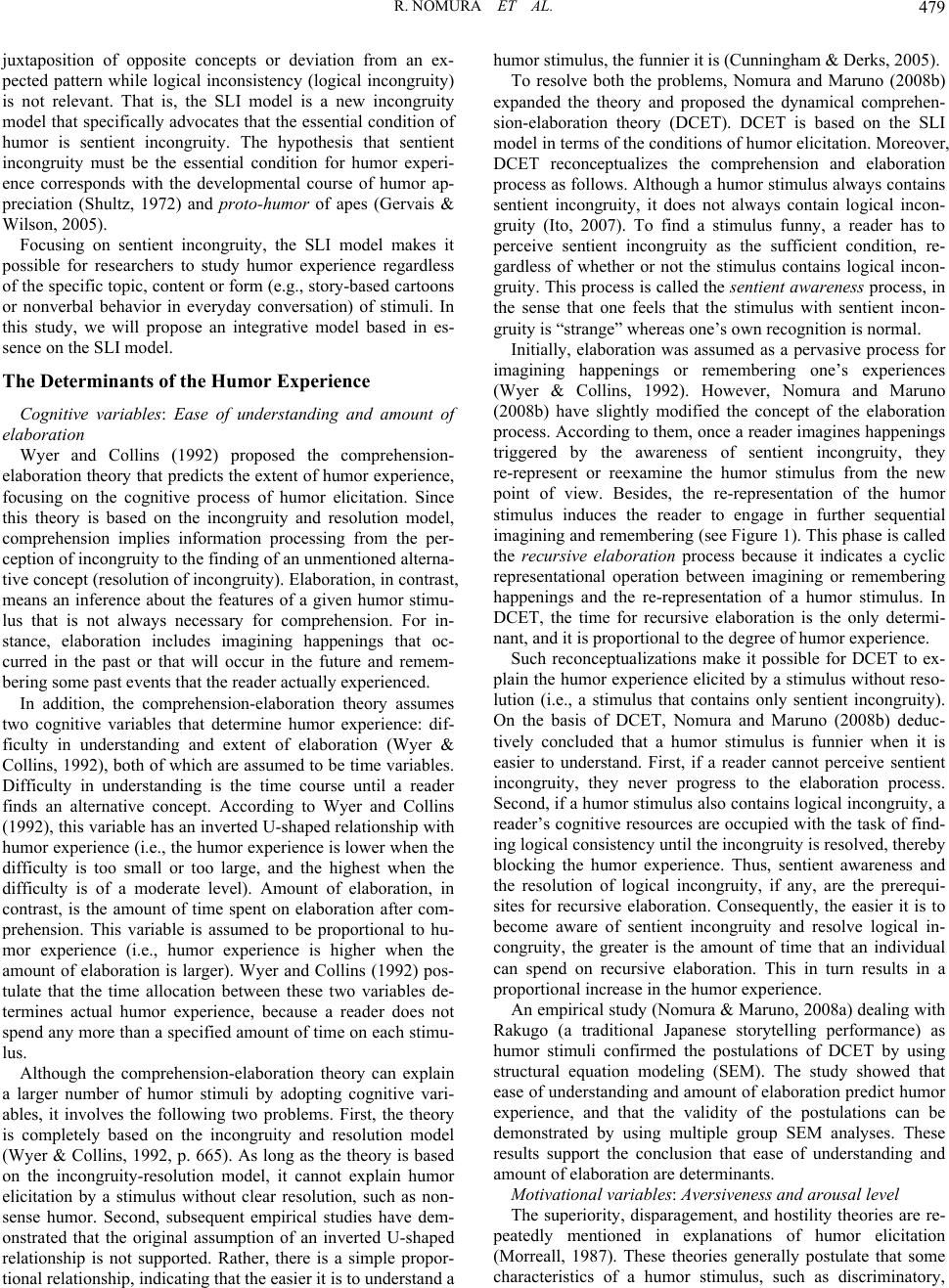 R. NOMURA ET AL. 479 juxtaposition of opposite concepts or deviation from an ex- pected pattern while logical inconsistency (logical incongruity) is not relevant. That is, the SLI model is a new incongruity model that specifically advocates that the essential condition of humor is sentient incongruity. The hypothesis that sentient incongruity must be the essential condition for humor experi- ence corresponds with the developmental course of humor ap- preciation (Shultz, 1972) and proto-humor of apes (Gervais & Wilson, 2005). Focusing on sentient incongruity, the SLI model makes it possible for researchers to study humor experience regardless of the specific topic, content or form (e.g., story-based cartoons or nonverbal behavior in everyday conversation) of stimuli. In this study, we will propose an integrative model based in es- sence on the SLI model. The Determinants of the Humor Experience Cognitive variables: Ease of understanding and amount of elaboration Wyer and Collins (1992) proposed the comprehension- elaboration theory that predicts the extent of humor experience, focusing on the cognitive process of humor elicitation. Since this theory is based on the incongruity and resolution model, comprehension implies information processing from the per- ception of incongruity to the finding of an unmentioned alterna- tive concept (resolution of incongruity). Elaboration, in contrast, means an inference about the features of a given humor stimu- lus that is not always necessary for comprehension. For in- stance, elaboration includes imagining happenings that oc- curred in the past or that will occur in the future and remem- bering some past events that the reader actually experienced. In addition, the comprehension-elaboration theory assumes two cognitive variables that determine humor experience: dif- ficulty in understanding and extent of elaboration (Wyer & Collins, 1992), both of which are assumed to be time variables. Difficulty in understanding is the time course until a reader finds an alternative concept. According to Wyer and Collins (1992), this variable has an inverted U-shaped relationship with humor experience (i.e., the humor experience is lower when the difficulty is too small or too large, and the highest when the difficulty is of a moderate level). Amount of elaboration, in contrast, is the amount of time spent on elaboration after com- prehension. This variable is assumed to be proportional to hu- mor experience (i.e., humor experience is higher when the amount of elaboration is larger). Wyer and Collins (1992) pos- tulate that the time allocation between these two variables de- termines actual humor experience, because a reader does not spend any more than a specified amount of time on each stimu- lus. Although the comprehension-elaboration theory can explain a larger number of humor stimuli by adopting cognitive vari- ables, it involves the following two problems. First, the theory is completely based on the incongruity and resolution model (Wyer & Collins, 1992, p. 665). As long as the theory is based on the incongruity-resolution model, it cannot explain humor elicitation by a stimulus without clear resolution, such as non- sense humor. Second, subsequent empirical studies have dem- onstrated that the original assumption of an inverted U-shaped relationship is not supported. Rather, there is a simple propor- tional relationship, indicating that the easier it is to understand a humor stimulus, the funnier it is (Cunningham & Derks, 2005). To resolve both the problems, Nomura and Maruno (2008b) expanded the theory and proposed the dynamical comprehen- sion-elaboration theory (DCET). DCET is based on the SLI model in terms of the conditions of humor elicitation. Moreover, DCET reconceptualizes the comprehension and elaboration process as follows. Although a humor stimulus always contains sentient incongruity, it does not always contain logical incon- gruity (Ito, 2007). To find a stimulus funny, a reader has to perceive sentient incongruity as the sufficient condition, re- gardless of whether or not the stimulus contains logical incon- gruity. This process is called the sentient awareness process, in the sense that one feels that the stimulus with sentient incon- gruity is “strange” whereas one’s own recognition is normal. Initially, elaboration was assumed as a pervasive process for imagining happenings or remembering one’s experiences (Wyer & Collins, 1992). However, Nomura and Maruno (2008b) have slightly modified the concept of the elaboration process. According to them, once a reader imagines happenings triggered by the awareness of sentient incongruity, they re-represent or reexamine the humor stimulus from the new point of view. Besides, the re-representation of the humor stimulus induces the reader to engage in further sequential imagining and remembering (see Figure 1). This phase is called the recursive elaboration process because it indicates a cyclic representational operation between imagining or remembering happenings and the re-representation of a humor stimulus. In DCET, the time for recursive elaboration is the only determi- nant, and it is proportional to the degree of humor experience. Such reconceptualizations make it possible for DCET to ex- plain the humor experience elicited by a stimulus without reso- lution (i.e., a stimulus that contains only sentient incongruity). On the basis of DCET, Nomura and Maruno (2008b) deduc- tively concluded that a humor stimulus is funnier when it is easier to understand. First, if a reader cannot perceive sentient incongruity, they never progress to the elaboration process. Second, if a humor stimulus also contains logical incongruity, a reader’s cognitive resources are occupied with the task of find- ing logical consistency until the incongruity is resolved, thereby blocking the humor experience. Thus, sentient awareness and the resolution of logical incongruity, if any, are the prerequi- sites for recursive elaboration. Consequently, the easier it is to become aware of sentient incongruity and resolve logical in- congruity, the greater is the amount of time that an individual can spend on recursive elaboration. This in turn results in a proportional increase in the humor experience. An empirical study (Nomura & Maruno, 2008a) dealing with Rakugo (a traditional Japanese storytelling performance) as humor stimuli confirmed the postulations of DCET by using structural equation modeling (SEM). The study showed that ease of understanding and amount of elaboration predict humor experience, and that the validity of the postulations can be demonstrated by using multiple group SEM analyses. These results support the conclusion that ease of understanding and amount of elaboration are determinants. Motivational variables: Aversiveness and arousal level The superiority, disparagement, and hostility theories are re- peatedly mentioned in explanations of humor elicitation (Morreall, 1987). These theories generally postulate that some characteristics of a humor stimulus, such as discriminatory, 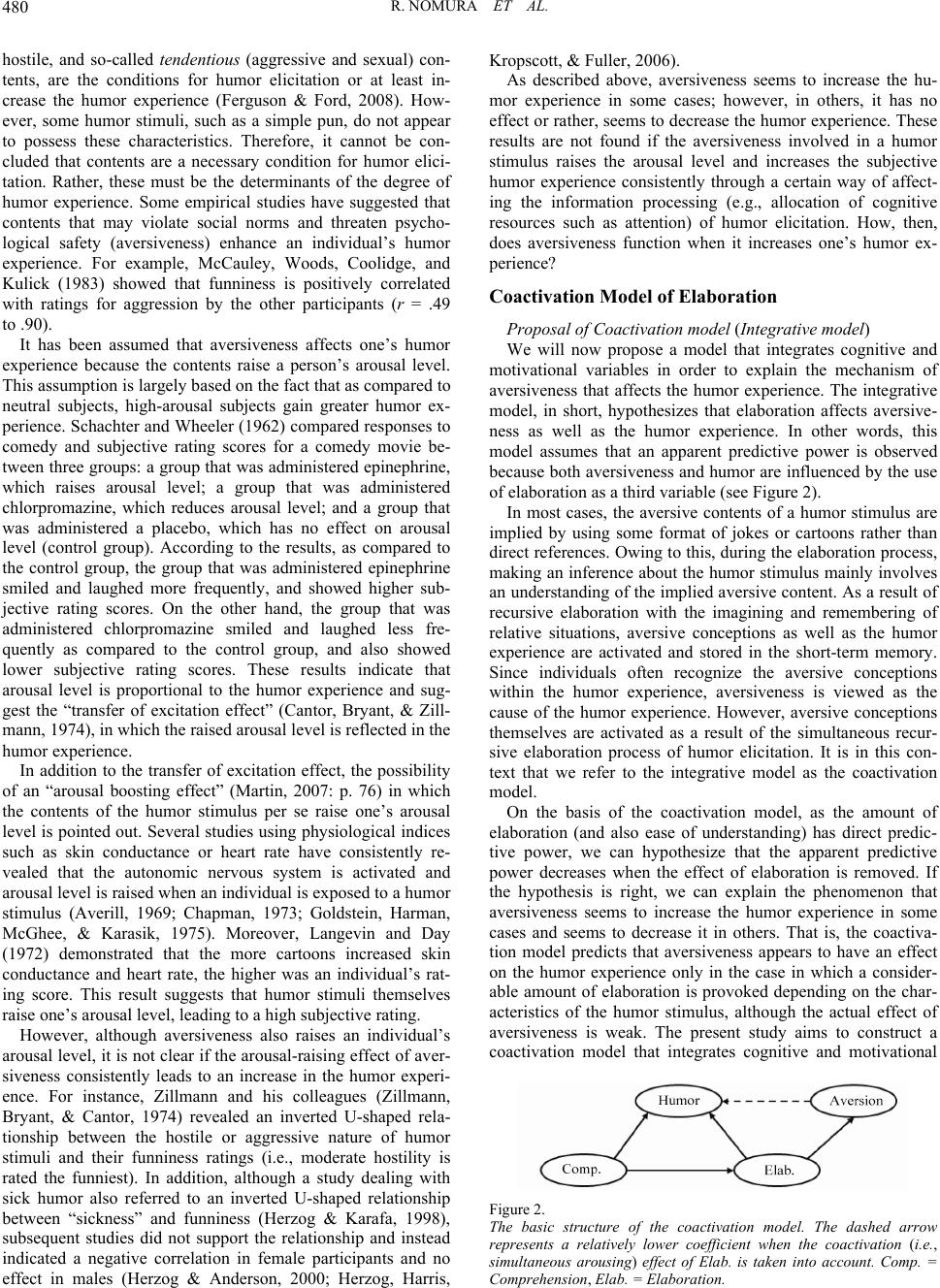 R. NOMURA ET AL. 480 hostile, and so-called tendentious (aggressive and sexual) con- tents, are the conditions for humor elicitation or at least in- crease the humor experience (Ferguson & Ford, 2008). How- ever, some humor stimuli, such as a simple pun, do not appear to possess these characteristics. Therefore, it cannot be con- cluded that contents are a necessary condition for humor elici- tation. Rather, these must be the determinants of the degree of humor experience. Some empirical studies have suggested that contents that may violate social norms and threaten psycho- logical safety (aversiveness) enhance an individual’s humor experience. For example, McCauley, Woods, Coolidge, and Kulick (1983) showed that funniness is positively correlated with ratings for aggression by the other participants (r = .49 to .90). It has been assumed that aversiveness affects one’s humor experience because the contents raise a person’s arousal level. This assumption is largely based on the fact that as compared to neutral subjects, high-arousal subjects gain greater humor ex- perience. Schachter and Wheeler (1962) compared responses to comedy and subjective rating scores for a comedy movie be- tween three groups: a group that was administered epinephrine, which raises arousal level; a group that was administered chlorpromazine, which reduces arousal level; and a group that was administered a placebo, which has no effect on arousal level (control group). According to the results, as compared to the control group, the group that was administered epinephrine smiled and laughed more frequently, and showed higher sub- jective rating scores. On the other hand, the group that was administered chlorpromazine smiled and laughed less fre- quently as compared to the control group, and also showed lower subjective rating scores. These results indicate that arousal level is proportional to the humor experience and sug- gest the “transfer of excitation effect” (Cantor, Bryant, & Zill- mann, 1974), in which the raised arousal level is reflected in the humor experience. In addition to the transfer of excitation effect, the possibility of an “arousal boosting effect” (Martin, 2007: p. 76) in which the contents of the humor stimulus per se raise one’s arousal level is pointed out. Several studies using physiological indices such as skin conductance or heart rate have consistently re- vealed that the autonomic nervous system is activated and arousal level is raised when an individual is exposed to a humor stimulus (Averill, 1969; Chapman, 1973; Goldstein, Harman, McGhee, & Karasik, 1975). Moreover, Langevin and Day (1972) demonstrated that the more cartoons increased skin conductance and heart rate, the higher was an individual’s rat- ing score. This result suggests that humor stimuli themselves raise one’s arousal level, leading to a high subjective rating. However, although aversiveness also raises an individual’s arousal level, it is not clear if the arousal-raising effect of aver- siveness consistently leads to an increase in the humor experi- ence. For instance, Zillmann and his colleagues (Zillmann, Bryant, & Cantor, 1974) revealed an inverted U-shaped rela- tionship between the hostile or aggressive nature of humor stimuli and their funniness ratings (i.e., moderate hostility is rated the funniest). In addition, although a study dealing with sick humor also referred to an inverted U-shaped relationship between “sickness” and funniness (Herzog & Karafa, 1998), subsequent studies did not support the relationship and instead indicated a negative correlation in female participants and no effect in males (Herzog & Anderson, 2000; Herzog, Harris, Kropscott, & Fuller, 2006). As described above, aversiveness seems to increase the hu- mor experience in some cases; however, in others, it has no effect or rather, seems to decrease the humor experience. These results are not found if the aversiveness involved in a humor stimulus raises the arousal level and increases the subjective humor experience consistently through a certain way of affect- ing the information processing (e.g., allocation of cognitive resources such as attention) of humor elicitation. How, then, does aversiveness function when it increases one’s humor ex- perience? Coactivation Model of Elaboration Proposal of Coactivation model (Integrative model) We will now propose a model that integrates cognitive and motivational variables in order to explain the mechanism of aversiveness that affects the humor experience. The integrative model, in short, hypothesizes that elaboration affects aversive- ness as well as the humor experience. In other words, this model assumes that an apparent predictive power is observed because both aversiveness and humor are influenced by the use of elaboration as a third variable (see Figure 2). In most cases, the aversive contents of a humor stimulus are implied by using some format of jokes or cartoons rather than direct references. Owing to this, during the elaboration process, making an inference about the humor stimulus mainly involves an understanding of the implied aversive content. As a result of recursive elaboration with the imagining and remembering of relative situations, aversive conceptions as well as the humor experience are activated and stored in the short-term memory. Since individuals often recognize the aversive conceptions within the humor experience, aversiveness is viewed as the cause of the humor experience. However, aversive conceptions themselves are activated as a result of the simultaneous recur- sive elaboration process of humor elicitation. It is in this con- text that we refer to the integrative model as the coactivation model. On the basis of the coactivation model, as the amount of elaboration (and also ease of understanding) has direct predic- tive power, we can hypothesize that the apparent predictive power decreases when the effect of elaboration is removed. If the hypothesis is right, we can explain the phenomenon that aversiveness seems to increase the humor experience in some cases and seems to decrease it in others. That is, the coactiva- tion model predicts that aversiveness appears to have an effect on the humor experience only in the case in which a consider- able amount of elaboration is provoked depending on the char- acteristics of the humor stimulus, although the actual effect of aversiveness is weak. The present study aims to construct a coactivation model that integrates cognitive and motivational Figure 2. The basic structure of the coactivation model. The dashed arrow represents a relatively lower coefficient when the coactivation (i.e., simultaneous arousing) effect of Elab. is taken into account. Comp. = Comprehension, Elab. = Elaboration. 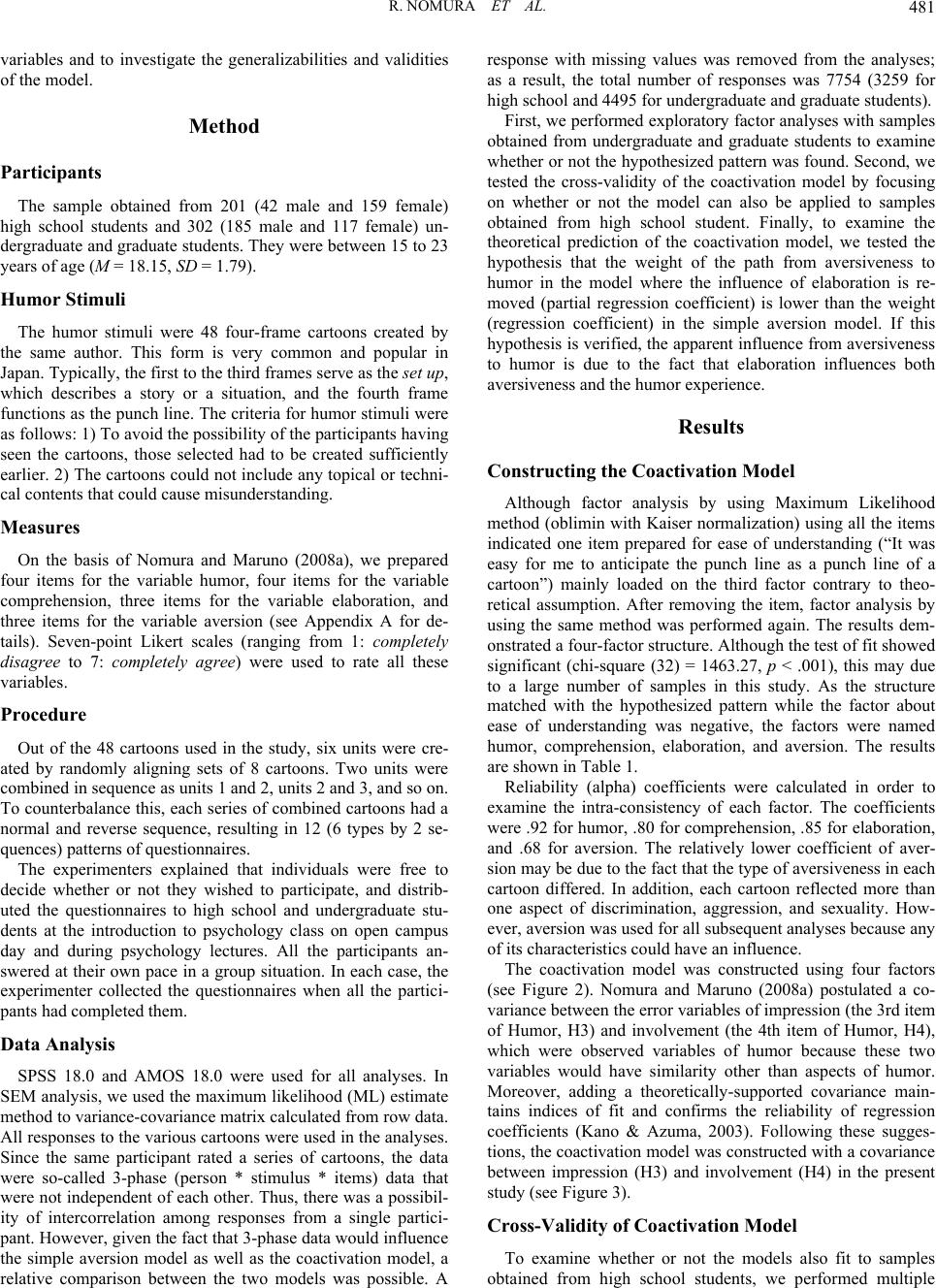 R. NOMURA ET AL. 481 variables and to investigate the generalizabilities and validities of the model. Method Participants The sample obtained from 201 (42 male and 159 female) high school students and 302 (185 male and 117 female) un- dergraduate and graduate students. They were between 15 to 23 years of age (M = 18.15, SD = 1.79). Humor Stimuli The humor stimuli were 48 four-frame cartoons created by the same author. This form is very common and popular in Japan. Typically, the first to the third frames serve as the set up, which describes a story or a situation, and the fourth frame functions as the punch line. The criteria for humor stimuli were as follows: 1) To avoid the possibility of the participants having seen the cartoons, those selected had to be created sufficiently earlier. 2) The cartoons could not include any topical or techni- cal contents that could cause misunderstanding. Measures On the basis of Nomura and Maruno (2008a), we prepared four items for the variable humor, four items for the variable comprehension, three items for the variable elaboration, and three items for the variable aversion (see Appendix A for de- tails). Seven-point Likert scales (ranging from 1: completely disagree to 7: completely agree) were used to rate all these variables. Procedure Out of the 48 cartoons used in the study, six units were cre- ated by randomly aligning sets of 8 cartoons. Two units were combined in sequence as units 1 and 2, units 2 and 3, and so on. To counterbalance this, each series of combined cartoons had a normal and reverse sequence, resulting in 12 (6 types by 2 se- quences) patterns of questionnaires. The experimenters explained that individuals were free to decide whether or not they wished to participate, and distrib- uted the questionnaires to high school and undergraduate stu- dents at the introduction to psychology class on open campus day and during psychology lectures. All the participants an- swered at their own pace in a group situation. In each case, the experimenter collected the questionnaires when all the partici- pants had completed them. Data Analysis SPSS 18.0 and AMOS 18.0 were used for all analyses. In SEM analysis, we used the maximum likelihood (ML) estimate method to variance-covariance matrix calculated from row data. All responses to the various cartoons were used in the analyses. Since the same participant rated a series of cartoons, the data were so-called 3-phase (person * stimulus * items) data that were not independent of each other. Thus, there was a possibil- ity of intercorrelation among responses from a single partici- pant. However, given the fact that 3-phase data would influence the simple aversion model as well as the coactivation model, a relative comparison between the two models was possible. A response with missing values was removed from the analyses; as a result, the total number of responses was 7754 (3259 for high school and 4495 for undergraduate and graduate students). First, we performed exploratory factor analyses with samples obtained from undergraduate and graduate students to examine whether or not the hypothesized pattern was found. Second, we tested the cross-validity of the coactivation model by focusing on whether or not the model can also be applied to samples obtained from high school student. Finally, to examine the theoretical prediction of the coactivation model, we tested the hypothesis that the weight of the path from aversiveness to humor in the model where the influence of elaboration is re- moved (partial regression coefficient) is lower than the weight (regression coefficient) in the simple aversion model. If this hypothesis is verified, the apparent influence from aversiveness to humor is due to the fact that elaboration influences both aversiveness and the humor experience. Results Constructing the Coactivation Model Although factor analysis by using Maximum Likelihood method (oblimin with Kaiser normalization) using all the items indicated one item prepared for ease of understanding (“It was easy for me to anticipate the punch line as a punch line of a cartoon”) mainly loaded on the third factor contrary to theo- retical assumption. After removing the item, factor analysis by using the same method was performed again. The results dem- onstrated a four-factor structure. Although the test of fit showed significant (chi-square (32) = 1463.27, p < .001), this may due to a large number of samples in this study. As the structure matched with the hypothesized pattern while the factor about ease of understanding was negative, the factors were named humor, comprehension, elaboration, and aversion. The results are shown in Table 1. Reliability (alpha) coefficients were calculated in order to examine the intra-consistency of each factor. The coefficients were .92 for humor, .80 for comprehension, .85 for elaboration, and .68 for aversion. The relatively lower coefficient of aver- sion may be due to the fact that the type of aversiveness in each cartoon differed. In addition, each cartoon reflected more than one aspect of discrimination, aggression, and sexuality. How- ever, aversion was used for all subsequent analyses because any of its characteristics could have an influence. The coactivation model was constructed using four factors (see Figure 2). Nomura and Maruno (2008a) postulated a co- variance between the error variables of impression (the 3rd item of Humor, H3) and involvement (the 4th item of Humor, H4), which were observed variables of humor because these two variables would have similarity other than aspects of humor. Moreover, adding a theoretically-supported covariance main- tains indices of fit and confirms the reliability of regression coefficients (Kano & Azuma, 2003). Following these sugges- tions, the coactivation model was constructed with a covariance between impression (H3) and involvement (H4) in the present study (see Figure 3). Cross-Validity of Coactivation Model To examine whether or not the models also fit to samples obtained from high school students, we performed multiple 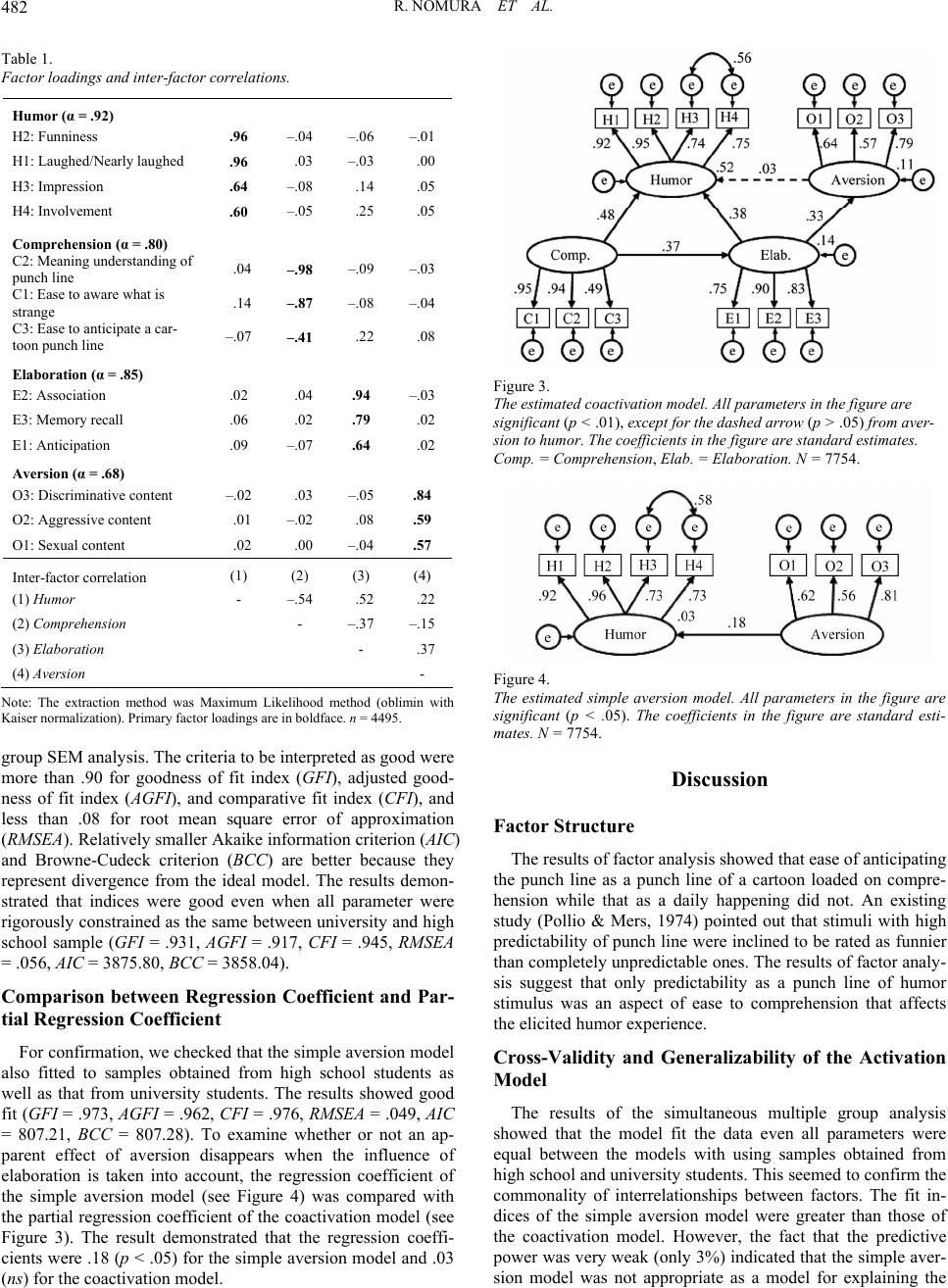 R. NOMURA ET AL. 482 Table 1. Factor loadings and inter-factor correlations. Humor (α = .92) H2: Funniness .96 –.04 –.06 –.01 H1: Laughed/Nearly laughed .96 .03 –.03 .00 H3: Impression .64 –.08 .14 .05 H4: Involvement .60 –.05 .25 .05 Comprehension (α = .80) C2: Meaning understanding of punch line .04 –.98 –.09 –.03 C1: Ease to aware what is strange .14 –.87 –.08 –.04 C3: Ease to anticipate a car- toon punch line –.07 –.41 .22 .08 Elaboration (α = .85) E2: Association .02 .04 .94 –.03 E3: Memory recall .06 .02 .79 .02 E1: Anticipation .09 –.07 .64 .02 Aversion (α = .68) O3: Discriminative content –.02 .03 –.05 .84 O2: Aggressive content .01 –.02 .08 .59 O1: Sexual content .02 .00 –.04 .57 Inter-factor correlation (1) (2) (3) (4) (1) Humor - –.54 .52 .22 (2) Comprehension - –.37 –.15 (3) Elaboration - .37 (4) Aversion - Note: The extraction method was Maximum Likelihood method (oblimin with Kaiser normalization). Primary factor loadings are in boldface. n = 4495. group SEM analysis. The criteria to be interpreted as good were more than .90 for goodness of fit index (GFI), adjusted good- ness of fit index (AGFI), and comparative fit index (CFI), and less than .08 for root mean square error of approximation (RMSEA). Relatively smaller Akaike information criterion (AIC) and Browne-Cudeck criterion (BCC) are better because they represent divergence from the ideal model. The results demon- strated that indices were good even when all parameter were rigorously constrained as the same between university and high school sample (GFI = .931, AGFI = .917, CFI = .945, RMSEA = .056, AIC = 3875.80, BCC = 385 8 .0 4 ) . Comparison between Regression Coefficient and Par- tial Regression Coefficient For confirmation, we checked that the simple aversion model also fitted to samples obtained from high school students as well as that from university students. The results showed good fit (GFI = .973, AGFI = .962, CFI = .976, RMSEA = .049, AIC = 807.21, BCC = 807.28). To examine whether or not an ap- parent effect of aversion disappears when the influence of elaboration is taken into account, the regression coefficient of the simple aversion model (see Figure 4) was compared with the partial regression coefficient of the coactivation model (see Figure 3). The result demonstrated that the regression coeffi- cients were .18 (p < .05) for the simple aversion model and .03 (ns) for the coactivation model. Figure 3. The estimated coactivation model. All parameters in the figure are significant (p < .01), except for the dashed arrow (p > .05) from aver- sion to humor. The coefficients in the figure ar e standard estimates. Comp. = Comprehension, Elab. = Elaboration. N = 7754. Figure 4. The estimated simple aversion model. All parameters in the figure are significant (p < .05). The coefficients in the figure are standard esti- mates. N = 7754. Discussion Factor Structure The results of factor analysis showed that ease of anticipating the punch line as a punch line of a cartoon loaded on compre- hension while that as a daily happening did not. An existing study (Pollio & Mers, 1974) pointed out that stimuli with high predictability of punch line were inclined to be rated as funnier than completely unpredictable ones. The results of factor analy- sis suggest that only predictability as a punch line of humor stimulus was an aspect of ease to comprehension that affects the elicited humor experience. Cross-Validity and Generalizability of the Activation Model The results of the simultaneous multiple group analysis showed that the model fit the data even all parameters were equal between the models with using samples obtained from high school and university students. This seemed to confirm the commonality of interrelationships between factors. The fit in- dices of the simple aversion model were greater than those of the coactivation model. However, the fact that the predictive power was very weak (only 3%) indicated that the simple aver- sion model was not appropriate as a model for explaining the 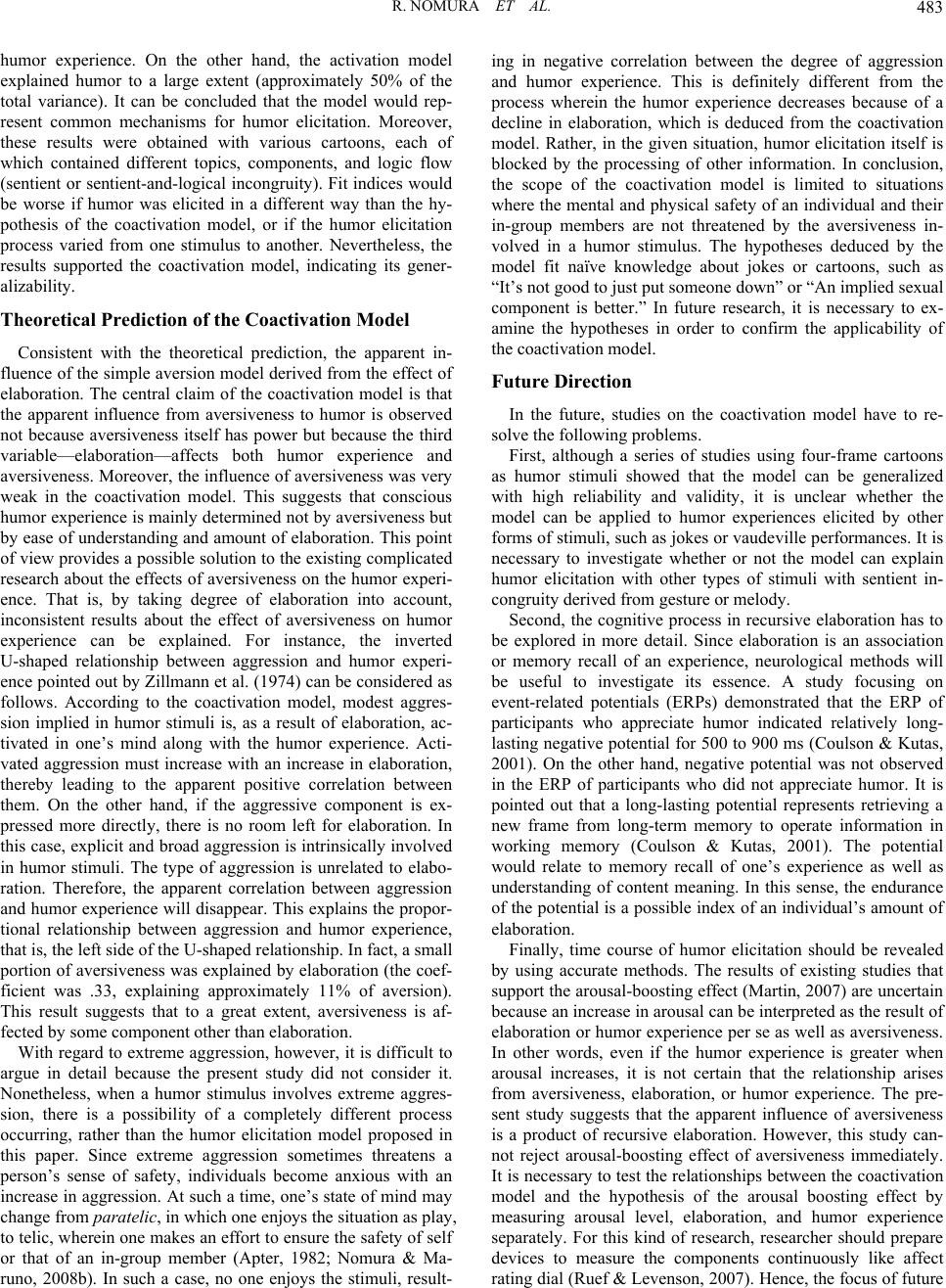 R. NOMURA ET AL. 483 humor experience. On the other hand, the activation model explained humor to a large extent (approximately 50% of the total variance). It can be concluded that the model would rep- resent common mechanisms for humor elicitation. Moreover, these results were obtained with various cartoons, each of which contained different topics, components, and logic flow (sentient or sentient-and-logical incongruity). Fit indices would be worse if humor was elicited in a different way than the hy- pothesis of the coactivation model, or if the humor elicitation process varied from one stimulus to another. Nevertheless, the results supported the coactivation model, indicating its gener- alizability. Theoretical Prediction of the Coactivation Model Consistent with the theoretical prediction, the apparent in- fluence of the simple aversion model derived from the effect of elaboration. The central claim of the coactivation model is that the apparent influence from aversiveness to humor is observed not because aversiveness itself has power but because the third variable—elaboration—affects both humor experience and aversiveness. Moreove r, the influence of aversiveness was very weak in the coactivation model. This suggests that conscious humor experience is mainly determined not by aversiveness but by ease of understanding and amount of elaboration. This point of view provides a possible solution to the existing complicated research about the effects of aversiveness on the humor experi- ence. That is, by taking degree of elaboration into account, inconsistent results about the effect of aversiveness on humor experience can be explained. For instance, the inverted U-shaped relationship between aggression and humor experi- ence pointed out by Zillmann et al. (1974) can be considered as follows. According to the coactivation model, modest aggres- sion implied in humor stimuli is, as a result of elaboration, ac- tivated in one’s mind along with the humor experience. Acti- vated aggression must increase with an increase in elaboration, thereby leading to the apparent positive correlation between them. On the other hand, if the aggressive component is ex- pressed more directly, there is no room left for elaboration. In this case, explicit and broad aggression is intrinsically involved in humor stimuli. The type of aggression is unrelated to elabo- ration. Therefore, the apparent correlation between aggression and humor experience will disappear. This explains the propor- tional relationship between aggression and humor experience, that is, the left side of the U-shaped relationship. In fact, a small portion of aversiveness was explained by elaboration (the coef- ficient was .33, explaining approximately 11% of aversion). This result suggests that to a great extent, aversiveness is af- fected by some component other t h a n elaboration . With regard to extreme aggression, however, it is difficult to argue in detail because the present study did not consider it. Nonetheless, when a humor stimulus involves extreme aggres- sion, there is a possibility of a completely different process occurring, rather than the humor elicitation model proposed in this paper. Since extreme aggression sometimes threatens a person’s sense of safety, individuals become anxious with an increase in aggression. At such a time, one’s state of mind may change from paratelic, in which one enjoys the situation as play, to telic, wherein one makes an effort to ensure the safety of self or that of an in-group member (Apter, 1982; Nomura & Ma- runo, 2008b). In such a case, no one enjoys the stimuli, result- ing in negative correlation between the degree of aggression and humor experience. This is definitely different from the process wherein the humor experience decreases because of a decline in elaboration, which is deduced from the coactivation model. Rather, in the given situation, humor elicitation itself is blocked by the processing of other information. In conclusion, the scope of the coactivation model is limited to situations where the mental and physic al safety of an individual and their in-group members are not threatened by the aversiveness in- volved in a humor stimulus. The hypotheses deduced by the model fit naïve knowledge about jokes or cartoons, such as “It’s not good to just put someone down” or “An implied sexual component is better.” In future research, it is necessary to ex- amine the hypotheses in order to confirm the applicability of the coactivation model. Future Direction In the future, studies on the coactivation model have to re- solve the following problems. First, although a series of studies using four-frame cartoons as humor stimuli showed that the model can be generalized with high reliability and validity, it is unclear whether the model can be applied to humor experiences elicited by other forms of stimuli, such as jokes or vaudeville performances. It is necessary to investigate whether or not the model can explain humor elicitation with other types of stimuli with sentient in- congruity derived from gesture or melody. Second, the cognitive process in recursive elaboration has to be explored in more detail. Since elaboration is an association or memory recall of an experience, neurological methods will be useful to investigate its essence. A study focusing on event-related potentials (ERPs) demonstrated that the ERP of participants who appreciate humor indicated relatively long- lasting negative potential for 500 to 900 ms (Coulson & Kutas, 2001). On the other hand, negative potential was not observed in the ERP of participants who did not appreciate humor. It is pointed out that a long-lasting potential represents retrieving a new frame from long-term memory to operate information in working memory (Coulson & Kutas, 2001). The potential would relate to memory recall of one’s experience as well as understanding of content meaning. In this sense, the endurance of the potential is a possible index of an individual’s amount of elaboration. Finally, time course of humor elicitation should be revealed by using accurate methods. The results of existing studies that support the arousal-boosting effect (Martin, 2007) are uncertain because an increase in arousal can be interpreted as the result of elaboration or humor experience per se as well as aversiveness. In other words, even if the humor experience is greater when arousal increases, it is not certain that the relationship arises from aversiveness, elaboration, or humor experience. The pre- sent study suggests that the apparent influence of aversiveness is a product of recursive elaboration. However, this study can- not reject arousal-boosting effect of aversiveness immediately. It is necessary to test the relationships between the coactivation model and the hypothesis of the arousal boosting effect by measuring arousal level, elaboration, and humor experience separately. For this kind of research, researcher should prepare devices to measure the components continuously like affect rating dial (Ruef & Levenson, 2007). Hence, the focus of future 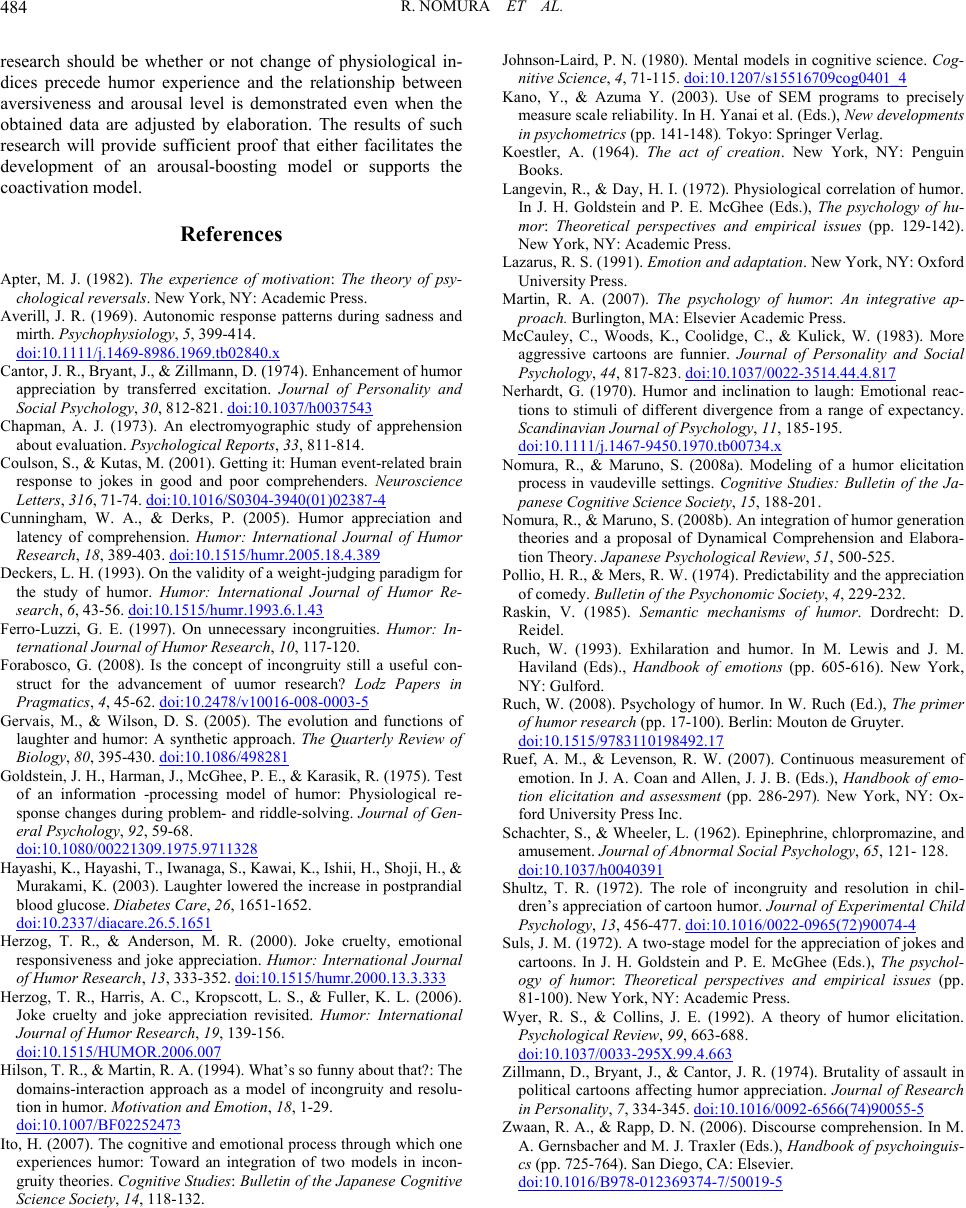 R. NOMURA ET AL. 484 research should be whether or not change of physiological in- dices precede humor experience and the relationship between aversiveness and arousal level is demonstrated even when the obtained data are adjusted by elaboration. The results of such research will provide sufficient proof that either facilitates the development of an arousal-boosting model or supports the coactivation model. References Apter, M. J. (1982). The experience of motivation: The theory of psy- chological reversals. New York, NY: Academic Press. Averill, J. R. (1969). Autonomic response patterns during sadness and mirth. Psychophysiology, 5, 399-414. doi:10.1111/j.1469-8986.1969.tb02840.x Cantor, J. R., Bryant, J., & Zillm ann, D. (1974). Enhancement of humor appreciation by transferred excitation. Journal of Personality and Social Psychology, 30, 812-821. doi:10.1037/h0037543 Chapman, A. J. (1973). An electromyographic study of apprehension about evaluation. Psycholo g i c a l Reports, 33, 811-814. Coulson, S., & Kutas, M. (2001). Getting it: Human event-related brain response to jokes in good and poor comprehenders. Neuroscience Letters, 316, 71-74. doi:10.1016/S0304-3940(01)02387-4 Cunningham, W. A., & Derks, P. (2005). Humor appreciation and latency of comprehension. Humor: International Journal of Humor Research, 18, 389-403. doi:10.1515/humr.2005.18.4.389 Deckers, L. H. (1993). On the validity of a weight- j ud ging p aradigm for the study of humor. Humor: International Journal of Humor Re- search, 6, 43-56. doi:10.1515/humr.1993.6.1.43 Ferro-Luzzi, G. E. (1997). On unnecessary incongruities. Humor: In- ternational Journal of H u m or Research, 10, 117-120. Forabosco, G. (2008). Is the concept of incongruity still a useful con- struct for the advancement of uumor research? Lodz Papers in Pragmatics, 4, 45-62. doi:10.2478/v10016-008-0003-5 Gervais, M., & Wilson, D. S. (2005). The evolution and functions of laughter and humor: A synthetic approach. The Quarterly Review of Biology, 80, 395-430. doi:10.1086/498281 Goldstein, J. H., Harman, J., McGhee, P. E., & Karasik, R. (1975). Test of an information -processing model of humor: Physiological re- sponse changes during problem- and riddle-solving. Journal of Gen- eral Psychology, 92, 59-68. doi:10.1080/00221309.1975.9711328 Hayashi, K., Hayashi, T., Iw anaga, S., Kawai, K., Ishii, H., Shoji, H., & Murakami, K. (2003). Laughter lowered the increase in postprandial blood glucose. Diabetes Care, 26, 1651-1652. doi:10.2337/diacare.26.5.1651 Herzog, T. R., & Anderson, M. R. (2000). Joke cruelty, emotional responsiveness and joke appreciation. Humor: International Journal of Humor Research, 13, 333-352. doi:10.1515/humr.2000.13.3.333 Herzog, T. R., Harris, A. C., Kropscott, L. S., & Fuller, K. L. (2006). Joke cruelty and joke appreciation revisited. Humor: International Journal of Humor Res e a r c h, 19, 139-156. doi:10.1515/HUMOR.2006.007 Hilson, T. R., & Martin, R. A. (1994). What’s so funny a bout tha t?: The domains-interaction approach as a model of incongruity and resolu- tion in humor. Motivation and Em ot ion, 18, 1-29. doi:10.1007/BF02252473 Ito, H. (2007). The cognitive and emotional process through which one experiences humor: Toward an integration of two models in incon- gruity theories. Cognitive Studies: Bulletin of the Japanese Cognitive Science Society, 14, 118-132. Johnson-Laird, P. N. (1980). Mental models in cognitive science. Cog- nitive Science, 4, 71- 115 . doi:10.1207/s15516709cog0401_4 Kano, Y., & Azuma Y. (2003). Use of SEM programs to precisely measure scale reliability. In H. Yanai et al. (Eds.), New developments in psychometrics (pp. 141-148). Tokyo: Springer Verlag. Koestler, A. (1964). The act of creation. New York, NY: Penguin Books. Langevin, R., & Day, H. I. (1972). Physiological correlation of humor. In J. H. Goldstein and P. E. McGhee (Eds.), The psychology of hu- mor: Theoretical perspectives and empirical issues (pp. 129-142). New York, NY: Academic Press. Lazarus, R. S. (1991). Emotion and adaptation. New York, NY: Oxford University Press. Martin, R. A. (2007). The psychology of humor: An integrative ap- proach. Burlington, MA: Elsevier Academic Press. McCauley, C., Woods, K., Coolidge, C., & Kulick, W. (1983). More aggressive cartoons are funnier. Journal of Personality and Social Psychology, 44, 817-823. doi:10.1037/0022-3514.44.4.817 Nerhardt, G. (1970). Humor and inclination to laugh: Emotional reac- tions to stimuli of different divergence from a range of expectancy. Scandinavian Journal of Ps ycho logy, 11, 185-195. doi:10.1111/j.1467-9450.1970.tb00734.x Nomura, R., & Maruno, S. (2008a). Modeling of a humor elicitation process in vaudeville settings. Cognitive Studies: Bulletin of the Ja- panese Cognitive Science Society, 15, 188-201. Nomura, R., & Maruno, S. (2008b). An integration of humor generation theories and a proposal of Dynamical Comprehension and Elabora- tion Theory. Japanes e Psychological Revie w, 51, 500-525. Pollio, H. R., & Mers, R. W. (1974). Predictability and the appreciation of comedy. Bulletin of the Psychonomic Society, 4, 229-232. Raskin, V. (1985). Semantic mechanisms of humor. Dordrecht: D. Reidel. Ruch, W. (1993). Exhilaration and humor. In M. Lewis and J. M. Haviland (Eds)., Handbook of emotions (pp. 605-616). New York, NY: Gulford. Ruch, W. (2008). Psychology of humor. In W. Ruch (Ed.), The primer of humor research (pp. 17-100). Berlin: Mouton de Gr uyter. doi:10.1515/9783110198492.17 Ruef, A. M., & Levenson, R. W. (2007). Continuous measurement of emotion. In J. A. Coan and Allen, J. J. B. (Eds.), Handbook of emo- tion elicitation and assessment (pp. 286-297). New York, NY: Ox- ford University Press Inc. Schachter, S., & Wheeler, L. (1962). Epinephrine, chlorpromazine, and amusement. Journal of Abnormal Social Psychology, 65, 121- 128. doi:10.1037/h0040391 Shultz, T. R. (1972). The role of incongruity and resolution in chil- dren’s appreciation of cartoon humor. Journal of Experimental Child Psychology, 13, 456-477. doi:10.1016/0022-0965(72)90074-4 Suls, J. M. (1972). A two-stage model for the appreciation of jokes and cartoons. In J. H. Goldstein and P. E. McGhee (Eds.), The psychol- ogy of humor: Theoretical perspectives and empirical issues (pp. 81-100). New York, NY: Academic Press. Wyer, R. S., & Collins, J. E. (1992). A theory of humor elicitation. Psychological Review, 99, 663-688. doi:10.1037/0033-295X.99.4.663 Zillmann, D., Bryant, J., & Cantor, J. R. (1974). Brutality of assault in political cartoons affecting humor appreciation. Journal of Research in Personality, 7, 334-345. doi:10.1016/0092-6566(74)90055-5 Zwaan, R. A., & Rapp, D. N. (2006). Discourse comprehension. In M. A. Gernsbacher and M. J. Traxler (Eds.), Handbook of psychoinguis- cs (pp. 725-764). San Diego, CA: Elsevier. doi:10.1016/B978-012369374-7/50019-5  R. NOMURA ET AL. 485 Appendix The list of questions asked in the questionnaires. An * indi- cates that the item was removed as a result of the first factor analysis. Humor H1. I found the cartoon funny. H2. I was inclined to laugh or laughed. H3. The cartoon made an impression on me. H4. I was drawn into the story. Aversion O1. I felt that the contents of the cartoon were discrimina- tory. O2. I felt that the contents of the cartoon were aggressive. O3. I felt that the contents of the cartoon were sexual. Comprehension C1. It was easy for me to understand the meaning of the punch line. C2. It was easy for me to identify what is funny (strange). C3. It was easy for me to anticipate the punch line as a punch line of a cartoon. *C4. It was easy for me to anticipate the punch line as a daily happening. Elaboration E1. I thought about things that were relevant to the contents of the cartoon. E2. I remembered some event relevant to the contents of the cartoon. E3. I imagined some event that will happen after this scene.
|